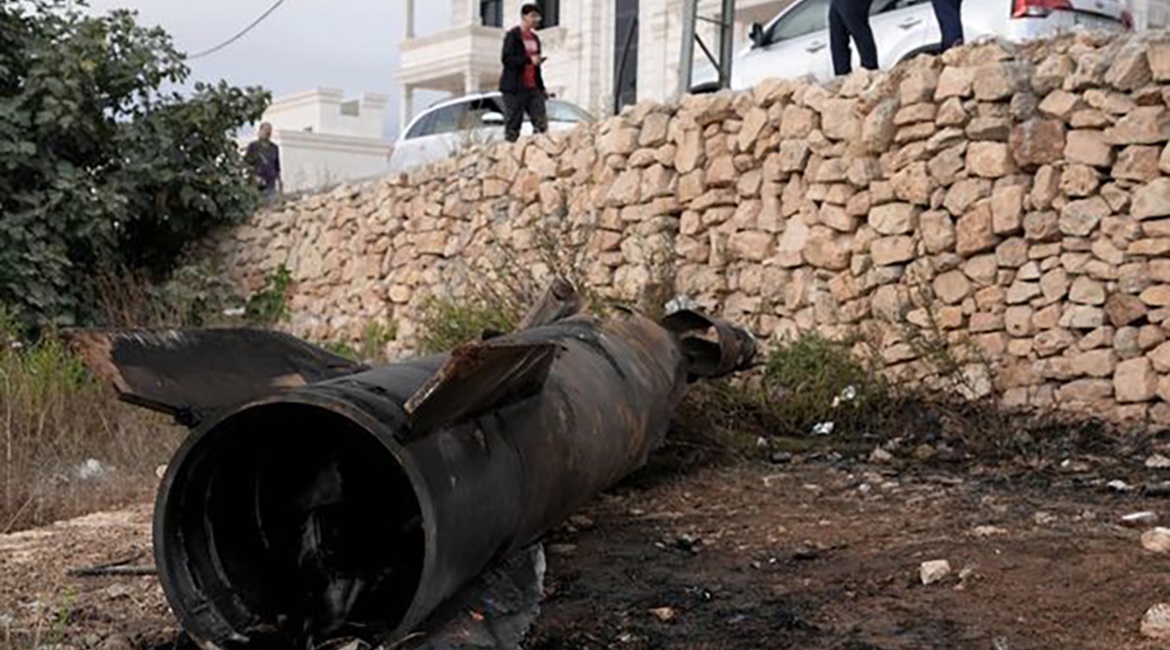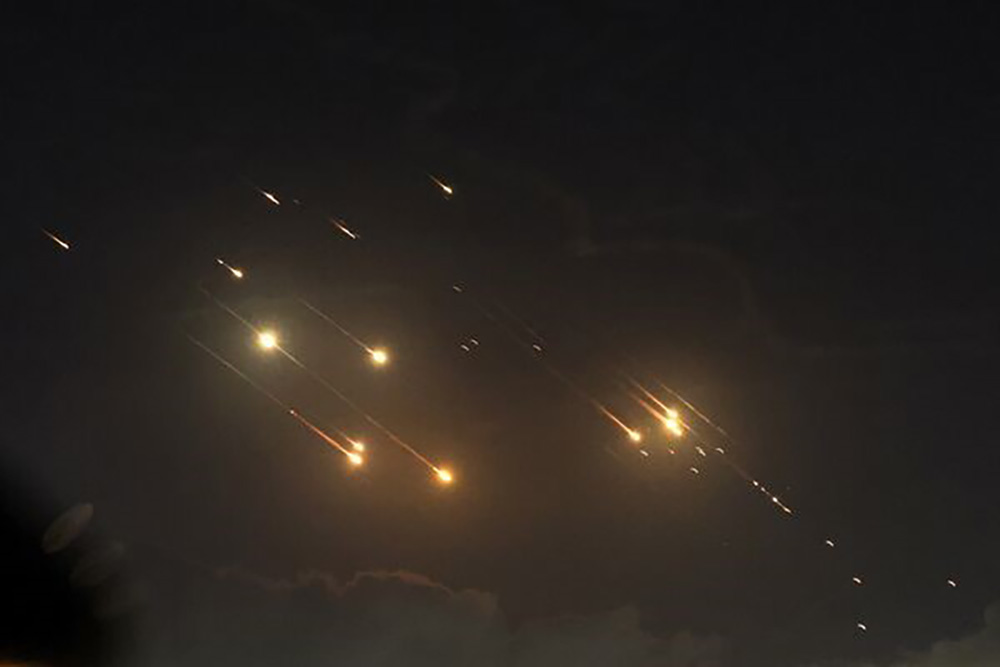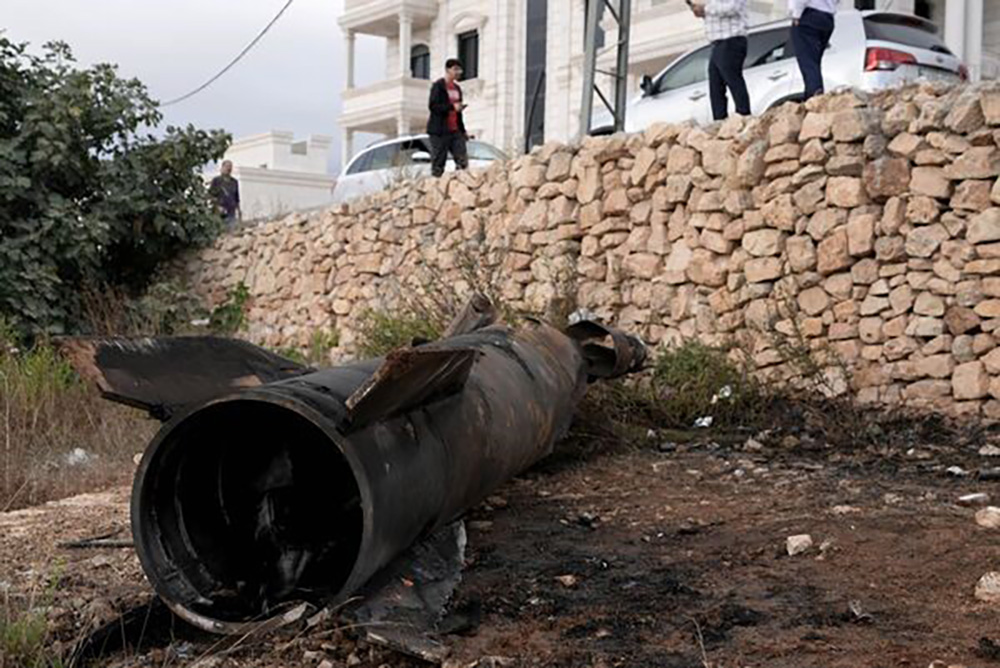
Date Posted: 02-Oct-2024
Author: Jeremy Binnie, London
Key points
- Israeli and US officials effectively conceded that a much lower percentage of Iranian weapons were intercepted than during the previous attack in April
- The IRGC used no cruise missiles or UAVs this time, but increased the number of ballistic missiles, and appears to have used different types
Iran's Operation ‘True Promise 2' ballistic missile attack against Israel on 1 October was clearly more successful than its predecessor on 13–14 April, but it is unclear if this was primarily due to the use of more or different types of ballistic missiles.
 The Iranian attack created dramatic images of ballistic missiles raining down as Israeli air defences attempted to intercept them. (AFP via Getty Images)
The Iranian attack created dramatic images of ballistic missiles raining down as Israeli air defences attempted to intercept them. (AFP via Getty Images)
After the 13–14 April attack, the Israel Defense Forces (IDF) claimed it shot down 99% of the 170 unmanned aerial vehicles (UAVs), 30 cruise missiles, and 120 ballistic missiles that Iran had launched in retaliation for an airstrike that destroyed an annex to its embassy in Damascus.
This interception rate seems to have been an exaggeration as the IDF confirmed that at least two missiles hit Nevatim Airbase without causing serious damage. US officials said roughly half the Iranian weapons failed in flight and the cruise missiles and UAVs appeared to have been relatively easy for fighter aircraft to shoot down as none of them reached Israeli airspace.
In contrast, IDF spokesperson Rear Admiral Daniel Hagari said the “majority” of more than 180 ballistic missiles that were launched on 1 October were intercepted. “There were a small number of hits in the centre of Israel and other hits in southern Israel,” he added.
In a press briefing soon after the attack, US Department of Defense spokesperson Major General Pat Ryder said Iran launched approximately 200 ballistic missiles at Israel and that initial reports indicated that the majority had been intercepted.
He added that US Navy destroyers had helped defend Israel by launching approximately a dozen interceptors against incoming Iranian missiles but declined to say whether any hit their targets. He was far more bullish about the performance of US forces in a 16 April press briefing, saying they had destroyed 80 UAVs and at least six ballistic missiles.
Iran's Islamic Revolution Guard Corps (IRGC) was also much more confident about its latest performance than it was after the first Operation ‘True Promise', when Major General Hossein Salami, its commander-in-chief, gave an interview to explain the complexities of penetrating Israeli missile defences, as well the air-defence capabilities the United States has in the region. This time it released a statement claiming that 90% of the missiles reached their target, with a different statement saying that 200 missiles were launched.
Different weapons
While this claim was highly questionable, the IRGC clearly significantly lowered its interception rate, partly by not using any cruise missiles or UAVs, although its Houthi allies in Yemen claimed to have launched three Quds-5 cruise missiles.
The IRGC also increased the number of ballistic missiles that it launched by at least 50%, although it is unclear if this played a significant part in overwhelming Israeli defences as it also appears to have used different types of weapons.
It has not directly identified the types used in either of its ‘True Promise' attacks. However, after the first one Iranian television aired footage purportedly showing the weapons being launched, which included solid-propellent missiles that could have been either Kheibar Shekan or Dezful types, as well as Emad versions of the Shahab-3/Ghadr liquid-fuel series.
The Iranian television again aired footage purportedly showing the launches after ‘True Promise 2'. One missile was clearly seen on its launcher and appeared to be a Ghadr with a smaller manoeuvring re-entry vehicle (MRV) than the one fitted to the Emad. This type was seen during the IRGC's Exercise ‘Great Prophet 17' in December 2021 but does not appear to have been publicly named.
 An expended rocket motor in Beit El in the West Bank could have come from a Kheibar Shekan or a Fattah. (Anadolu via Getty Images)
An expended rocket motor in Beit El in the West Bank could have come from a Kheibar Shekan or a Fattah. (Anadolu via Getty Images)
Meanwhile, the Iranian media reported that the missiles included the Fattah, a solid-propellent type with an MRV that has its own rocket motor that supposedly enables it to reach speeds of up to Mach 13, making it far harder to intercept. The discarded rocket motors that were photographed in the West Bank after the attack could have come from Kheibar Shekan or Fattah missiles.
The Houthis hinted that they may have used a similar weapon they called the Filasteen-2 on 15 September, describing it has a two-stage solid-propellent missile that could reach Mach 16. The IDF admitted it failed to intercept the missile, which it said appeared to have broken up after re-entry.
Accuracy
In a statement, Major General Mohammad Bagheri, the IRGC officer who serves as the commander-in-chief of the Iranian military, said Operation ‘True Promise 2' targeted three military facilities in Israel that he identified as the external intelligence agency Mossad's “assassination centre”; Nevatim Airbase, where F-35 aircraft are based; and Hatzerim Airbase, which he identified as the one used by the aircraft that carried out the airstrike that killed Hizbullah leader Hassan Nasrallah. He added that strategic radars and gathering centres for armoured vehicles and personnel were also targeted.
However, the IRGC still appears to be struggling with the accuracy of its missiles. This enabled the IDF to present the attack as indiscriminate, with Home Front Commander Major General Rafi Milo visiting a school in Gedera where one missile impacted. The crater's location was approximately 5 km southwest of Tel Nof Airbase, 7 km northeast of Hatzor Airbase, and 12 km west of the Tal Shahar air-defence base, making it unclear which was the intended target.
The media recorded another crater in the Glilot area north of Tel Aviv that was approximately 500 m from a facility that has been identified as Mossad's headquarters, which did not appear to have been damaged.
The Times of Israel later reported the IDF as saying some missiles had hit airbases, but they had been classified as ineffective because they had not damaged aircraft or disrupted operations. The IDF also said that only two Israelis had been lightly injured during the attack, although CCTV showed a Palestinian man was killed when a discarded solid rocket motor landed on him.
For more information, please see Analysis: Long-range Iranian attack on Israel thwarted with US help.





